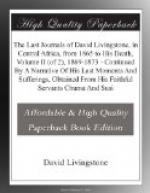30th May, 1872, Sunday.—Sent over to Sultan bin Ali, to write another note to Lewale, to say first note not needed.
31st May, 1872.—The so-called Arab war with Mirambo drags its slow length along most wearily. After it is over then we shall get Banyamwezi pagazi in abundance. It is not now known whether Mirambo is alive or not: some say that he died long ago, and his son keeps up his state instead.
In reference to this Nile source I have been kept in perpetual doubt and perplexity. I know too much to be positive. Great Lualaba, or Lualubba, as Manyuema say, may turn out to be the Congo and Nile, a shorter river after all—the fountains flowing north and south seem in favour of its being the Nile. Great westing is in favour of the Congo. It would be comfortable to be positive like Baker. “Every drop from the passing shower to the roaring mountain torrent must fall into Albert Lake, a giant at its birth.” How soothing to be positive.
1st June, 1872.—Visited by Jemadar Hamees from Katanga, who gives the following information.
UNYANYEMBE, Tuesday.—Hamees bin Jumaadarsabel, a Beluch, came here from Katanga to-day. He reports that the three Portuguese traders, Jao, Domasiko, and Domasho, came to Katanga from Matiamvo. They bought quantities of ivory and returned: they were carried in Mashilahs[21] by slaves. This Hamees gave them pieces of gold from the rivulet there between the two copper or malachite hills from which copper is dug. He says that Tipo Tipo is now at Katanga, and has purchased much ivory from Kayomba or Kayombo in Rua. He offers to guide me thither, going first to Merere’s, where Amran Masudi has now the upper hand, and Merere offers to pay all the losses he has caused to Arabs and others. Two letters were sent by the Portuguese to the East Coast, one is in Amran’s hands. Hamees Wodin Tagh is alive and well. These Portuguese went nowhere from Katanga, so that they have not touched the sources of the Nile, for which I am thankful.
Tipo Tipo has made friends with Merosi, the Monyamweze headman at Katanga, by marrying his daughter, and has formed the plan of assaulting Casembe in conjunction with him because Casembe put six of Tipo Tipo’s men to death. He will now be digging gold at Katanga till this man returns with gunpowder.
[Many busy calculations are met with here which are too involved to be given in detail. At one point we see a rough conjecture as to the length of the road through Fipa.]
On looking at the projected route by Merere’s I seethat it will be a saving of a large angle into Fipa = 350 into Basango country S.S.W. or S. and by W., this comes into Lat. 10’ S., and from this W.S.W. 400’ to Long. of Katanga, skirting Bangweolo S. shore in 12 deg. S. = the whole distance = 750’, say 900’.
[Further on we see that he reckoned on his work occupying him till 1874.]
If Stanley arrived the 1st of May at Zanzibar:—allow = 20 days to get men and settle with them = May 20th, men leave Zanzibar 22nd of May = now 1st of June.




